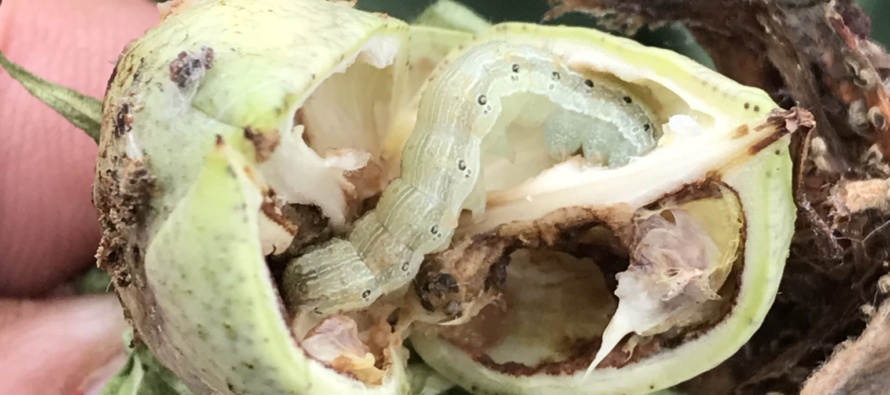Bollworm Management in Cotton: 2019 Guidelines

Related Articles
- Fertilizing Cotton with Poultry Litter 5
- Mississippi Cotton Insect Situation of 2010: A Look Back 3
- Bayer CropScience-O.A. Cleveland Weekly Cotton Commentary 0
Latest Tweets
As we write this article, July 10, 2019, there are only sporadic reports of bollworm eggs beginning to show up in MS cotton. Generally the first big bollworm flight begins around the week of July 4 and peaks around July 15. This flight is almost completely coming from corn in the month of July. As a result, the exact timing of the flight is highly dependent on planting date of corn. This year we have corn planting dates spread out more than we have witnessed in previous years. What will that mean for bollworms? There are two possible scenarios we may see play out this year. 1) A long extended flight due to various planting dates of corn, causing us to deal with worms for a longer period of time. 2) The later planting dates that are silking in the areas where moths are emerging will serve as a more preferred host and pull those worms into the later corn rather than beans or cotton. At this time we do believe we will definitely have our share in cotton in the coming days and weeks but there is no doubt if later planted corn is silking in the area it will be the preferred host.
Additionally, because corn plantings are spread out, bollworm egg lays may be very erratic depending on your location and age of corn in the area. Some may see heavy egg lays while others not much to light numbers. More than ever, it could be field to field situations this year.
Over the last couple years we have seen numerous escapes in BollGard 2 cotton varieties due to resistance to the Cry genes. As a result, the two gene cottons such as BollGard 2, WideStrike, and TwinLink have required oversprays for protection against bollworms. Two years ago we published egg thresholds that have increased control in these technologies greatly. Products of choice are the diamide insecticides such as Prevathon and Besiege. These products have provided roughly 14 days residual control at the low rates, 14 oz and 7 oz respectively. At the higher rates of 20 oz of Prevathon or 10 oz of Besiege, we have seen longer residual, up to 20 days. Keep in mind when we talk about residual control, these are not guarantees, rather just what we typically observe. We are at a point now that the probability of bollworm eggs successfully surviving the two gene cotton is extremely high, making the egg threshold the preferred treatment trigger. At this time we are not recommending treating cotton containing the VIP gene such as BollGard 3, WideStrike 3, or TwinLink Plus on eggs.
2019 Recommendations:
- Non-Bt, WideStrike, TwinLink, and BG2 cotton varieties: Before bloom: Treat when population reaches or exceeds 8 larvae/100 plants or 6% fruit injury of any kind. After bloom: Treat when you find 20 eggs/100 plants or 6% fruit injury of any kind. Regardless of size of larvae, treatment may be warranted if damaged-boll counts exceed 2 percent and significant numbers of larvae are present and continuing to cause damage *If treating on eggs with a diamide insecticide, do not make additional diamide applications on eggs sooner than 12-14 days after application.
- WideStrike 3, TwinLink Plus, and BG3 cotton varieties: Before bloom: Treat when population reaches or exceeds 8 larvae/100 plants or 6% fruit injury of any kind. After Bloom: Treat when larvae 1/8-inch long or longer exceed 4 larvae/100 plants or 6% fruit injury of any kind. Regardless of size of larvae, treatment may be warranted if damaged-boll counts exceed 2 percent and significant numbers of larvae are present and continuing to cause damage.
The one best piece of advice I can give you from the work we have done when treating eggs with diamides, EARLY IS BETTER THAN LATE.




Let me tell You a sad story ! There are no comments yet, but You can be first one to comment this article.
Write a comment